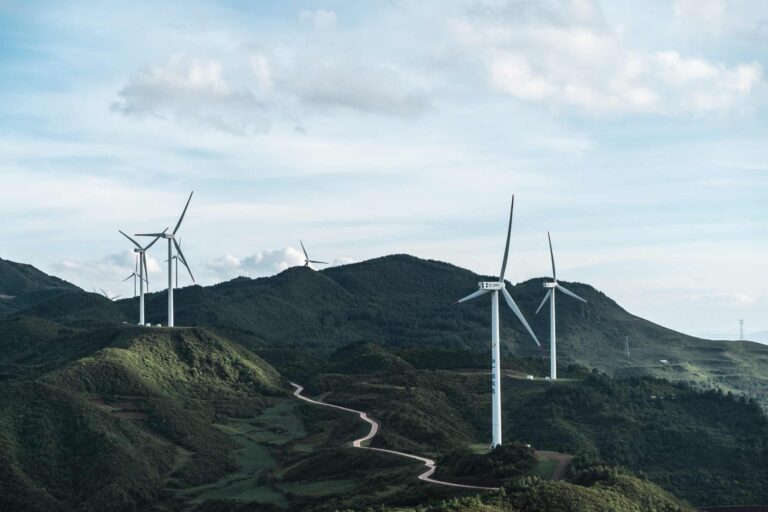As nations switch from using fossil fuels to low-carbon alternatives in an effort to decrease emissions and slow global warming, wind energy capacity is expanding quickly around the world.
Wind energy in contrast to other methods like solar panels or the burning of fossil fuels, refers to the electricity produced by harnessing the power of the wind. The best power production is achievable with wind power, which is safe, sustainable, renewable, and easy to scale up or down in size.
Eolic energy is produced by using wind turbines, whose blades rotate when the wind blows. This spinning of the blades, either directly or indirectly through a series of gears, spins a generator, which in turn spins an electric generator, producing electricity.
Table of Contents
7 countries leading in wind energy production
Here are some of the leading countries in wind energy production.
1. China
China is the greatest base for producing wind power equipment, on land, China is thought to have 2,380 GW of usable capacity and at water. With 6.1% of all power generation, wind power was still China’s third-largest source of electricity by the end of 2020.
In order to fulfill the government’s promise to raise the proportion of non-fossil fuels in primary energy consumption to about 25% by that year, China predicts to have 1200 GW of combined wind and solar capacity.
China’s emissions can peak before 2030, according to experts, and it can become carbon neutral before 2060.
2. USA
Having added 96.4 GW of capacity, the US comes in second. Six of the ten biggest onshore wind farms are in this nation. They include the second-largest onshore wind farm in the world, the Alta Wind Energy Centre in California, which has a 1,548 MW capacity.
Over 50% of the eolic energy produced worldwide came from China and the United States collectively.
3. Germany
With a national fleet totaling slightly under 63 GW of installed capacity, split between 55 GW onshore and 7.7 GW offshore, Germany is the most popular location in Europe for the development of wind energy.
According to the trade organization Wind Europe, wind energy provided 27% of Germany’s electricity in 2020, with onshore sources supplying 103 terawatt hours (TWh) and offshore sources generating 27 TWh.
In 2020, the nation’s capacity increased by 1.67 GW. In comparison to 2019, offshore installations significantly decreased.
4. India
In recent years, India’s ability to generate wind energy has considerably increased. The overall installed wind power capacity as of autumn 2022 was 41.666 gigawatts (GW), ranking it as the fourth highest installed wind power capacity worldwide.
States in the south, west, and northwest have the most wind power capacity. With the state of Tamil Nadu alone having more capacity, India is another superpower leading the switch to wind energy.
The entire installed wind power capacity was approximately 40.800 megawatts as of 2022, ranking it as the fourth highest installed wind power capacity worldwide.
5. Spain
Wind power is the primary source of renewable energy generation in Spain with an installed capacity of 28,336 MW. This capacity increased by 3.0% in 2021 compared to 2020. Or 839 MW more installed across the entire territory of Spain.
The technology with the largest share in the structure of installed capacity as of December 31, 2021 is wind power. Which accounts for one-fourth of the country’s installed capacity.
6. United Kingdom
The United Kingdom is one of the top countries in the world and the best country in Europe for wind power. The UK has the sixth-largest installed capacity of any nation by 2023 with over 11,000 wind turbines. Totaling 28 gigawatts (GW): 14 GW onshore and 14 GW offshore).
Around 25% of the country’s electricity came from wind in 2018, surpassing both coal and nuclear energy. In the UK, it is the biggest source of renewable electricity.
Since 2023, all forms of wind energy have reduced electricity costs. While in the past, onshore projects developed before the middle of 2010 and offshore projects built before the end of 2010 occasionally raised costs.
7. Brazil
Brazil installed 22 GW as of July 2022. The country is the 7th on the list for installed wind power. Thus trailing only China, the United States, and Germany amongst others.
Brazil had an 18.9 GW installed wind power capacity as of August 2021, with 16.4 GW in the Northeast and 2.0 GW in the South.
From June to December, when rainfall intensity is at its lowest, winds are more ferocious. This positions wind as a possible energy source that could complement hydroelectricity.
The advantages of exploiting the power of wind
There are significant advantages from the wider adoption of wind energy. The usage of wind energy is still in its infancy in many nations. Additionally, adjustments are necessary to the way the markets and electricity systems run in many nations of the world.
When turbines are used to generate energy, the emissions of carbon dioxide, nitrogen oxide, and sulphur dioxide will eventually decline. Thus, the usage of wind energy may help to mitigate acid rain, climate change, and other severe environmental issues.












